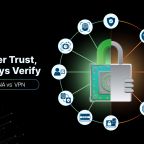Integrating RPAM, ZTNA, and VDI in Modern IT Environments
June 12, 2024
Overview
Thanks for following along with our series on how integrating modern IT solutions can make your operations smoother and more secure. We’ve explored the fundamentals of RPAM, ZTNA, and VDI, and now we’ll dive into best practices and how Thinfinity can help your business grow without adding IT complexity.
Understanding the Core Concepts
Remote Privileged Access Management (RPAM)
RPAM focuses on managing and securing privileged access to critical resources. It includes features like just-in-time access, approval workflows, session monitoring, and auditing. By ensuring privileged access is granted only when necessary, RPAM minimizes the risk of unauthorized access and potential security breaches.
Zero Trust Network Access (ZTNA)
ZTNA enforces strict identity verification and access controls, regardless of the user’s location or device. It operates on the principle of “never trust, always verify,” ensuring access is granted based on continuous verification of user identity, device health, and context. ZTNA provides a more secure and scalable solution for remote access compared to traditional VPNs.
Virtual Desktop Infrastructure (VDI)
VDI involves hosting desktop environments on a centralized server and providing users access to these virtual desktops from any device. VDI enhances security by keeping data within the corporate network and reducing the risk of data loss from endpoint devices. It also simplifies desktop management and ensures a consistent user experience across different devices.
Integrating RPAM, ZTNA, and VDI
Integrating RPAM, ZTNA, and VDI can create a secure and efficient environment for remote access and desktop management. Here are the key steps and best practices for implementing this integrated approach:
1. Assessing Organizational Needs
Before diving into the implementation, assess your organization’s specific needs and challenges. Identify critical assets, understand user roles, and determine the access level required for different user groups. A thorough assessment helps in designing a solution that meets your security and operational requirements.
2. Implementing Strong Authentication and Access Controls
Strong authentication methods, like multi-factor authentication (MFA), are crucial for securing access to critical resources. ZTNA enforces granular access controls based on user identity, device health, and contextual signals such as geographic location and time of access. By integrating RPAM, you can further enhance security by implementing just-in-time access and approval workflows for privileged accounts.
3. Deploying VDI for Enhanced Security and Efficiency
VDI provides a centralized and secure environment for managing desktop access. By hosting virtual desktops on centralized servers, organizations can ensure data remains within the corporate network, reducing the risk of data breaches. VDI also enables seamless access to applications and data from any device, enhancing user productivity.
4. Leveraging Cloud VDI for Scalability and Flexibility
Cloud VDI solutions offer scalability and flexibility, allowing organizations to adapt to changing business needs quickly. By leveraging cloud infrastructure, businesses can scale their virtual desktop environments up or down based on demand, without significant upfront investments in hardware. Cloud VDI also provides built-in redundancy and disaster recovery capabilities, ensuring continuous availability of desktop resources.
5. Continuous Monitoring and Auditing
Continuous monitoring and auditing are critical for maintaining security and integrity in the integrated environment. RPAM solutions provide session monitoring and recording capabilities, enabling organizations to track and audit privileged access activities. ZTNA solutions offer continuous verification and monitoring of user sessions, ensuring access is always based on up-to-date information. Regular audits help identify potential security gaps and ensure compliance with regulatory requirements.
Best Practices for Implementation
1. Standardize Access Policies
Establishing standard access policies for different user groups and roles simplifies the implementation and management of RPAM, ZTNA, and VDI. These policies should define the access level required for each role and the conditions under which access is granted. Standardizing access policies ensures consistency and reduces the complexity of managing access controls.
2. Educate and Train Users
User education and training are essential for successfully implementing RPAM, ZTNA, and VDI. Employees should be aware of security policies and procedures, understand the importance of privileged access management, and know how to use the virtual desktop environment effectively. Regular training sessions and awareness programs can help reinforce best practices and ensure compliance.
3. Ensure Seamless Integration
Seamless integration of RPAM, ZTNA, and VDI is crucial for achieving a cohesive security framework. Organizations should select solutions that are compatible and can be integrated with existing IT infrastructure. APIs and connectors can facilitate the integration of different components, ensuring they work together seamlessly to provide a unified security solution.
4. Prioritize User Experience
While security is paramount, it is also important to prioritize the user experience. The implementation of RPAM, ZTNA, and VDI should not create unnecessary barriers or hinder productivity. Solutions should be user-friendly and provide a seamless experience across different devices. Regular feedback from users can help identify areas for improvement and ensure that the solutions meet their needs.
5. Plan for Scalability and Future Growth
Organizations should plan for scalability and future growth when implementing RPAM, ZTNA, and VDI. This includes selecting solutions that can scale to accommodate an increasing number of users and devices, as well as future-proofing the infrastructure to support new technologies and business requirements. Regular reviews and updates to the security framework can help ensure that it remains effective and aligned with organizational goals.
How Thinfinity Can Help
Thinfinity Workspace excels in integrating the capabilities of ZTNA, RPAM, and VDI to provide a robust and comprehensive solution for modern IT environments. Thinfinity offers several features that make it an ideal choice for businesses looking to enhance their security and efficiency:
ZTNA Capabilities
Thinfinity provides secure, controlled connectivity without the need for traditional VPNs. It integrates with identity providers like Okta and Duo, enforcing strict identity verification and access controls. With features such as IP blacklisting, GeoIP filtering, and brute force detection, Thinfinity ensures a high level of security and compliance with ZTNA principles.
RPAM Capabilities
Thinfinity’s RPAM features include resource reservation, just-in-time access, approval workflows, and comprehensive session monitoring and recording. These capabilities ensure that privileged access is granted only when necessary and under controlled conditions, reducing the risk of unauthorized access and potential security breaches.
VDI and Cloud VDI Capabilities
Thinfinity supports the deployment of virtual desktops and applications on various infrastructures, including major cloud providers such as AWS, Azure, and Google Cloud. It offers automatic provisioning, load balancing, and seamless integration with existing IT environments. Thinfinity’s VDI solutions enable businesses to provide a consistent and secure desktop experience across different devices, enhancing productivity and reducing the risk of data breaches.
Enhanced User Experience
Thinfinity prioritizes user experience by providing a seamless and intuitive interface for accessing virtual desktops and applications. With support for multiple virtualization protocols and local-like user experience, Thinfinity ensures that users can access their resources efficiently and without unnecessary barriers.
Conclusion
Integrating Remote Privileged Access Management (RPAM), Zero Trust Network Access (ZTNA), and Virtual Desktop Infrastructure (VDI) provides a comprehensive framework for securing and managing remote access to critical IT resources. By implementing strong authentication and access controls, leveraging cloud VDI for scalability, and continuously monitoring and auditing access activities, organizations can enhance their security posture and ensure a seamless user experience. Thinfinity Workspace offers a robust and comprehensive solution that excels in integrating these capabilities, providing businesses with the tools they need to stay secure and efficient in today’s digital landscape. Adopting best practices for implementation and prioritizing user education and training further contributes to the success of this integrated approach. As the digital landscape continues to evolve, organizations must remain vigilant and proactive in adapting their security strategies to protect their valuable assets and ensure business continuity.
Transform Your IT Operations with Thinfinity Workspace
Are you ready to take your IT security and efficiency to the next level? Thinfinity Workspace integrates RPAM, ZTNA, and VDI to provide a robust, scalable solution tailored to your business needs. Discover how our platform can streamline your operations and protect your valuable assets.
Unlock the Full Potential of Your IT Infrastructure
Experience how integrating Remote Privileged Access Management (RPAM), Zero Trust Network Access (ZTNA), and Virtual Desktop Infrastructure (VDI) with Thinfinity Workspace can transform your IT operations. See firsthand how our comprehensive, user-friendly solution enhances security, efficiency, and user experience.




